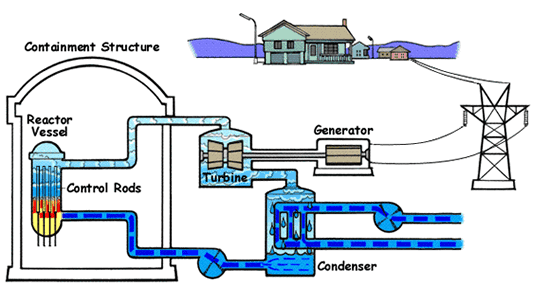Nuclear Power
Now you know the basics of nuclear reactions. Of the three we looked at, just one is the process used to generate nuclear power: nuclear fission. Nuclear power is derived from a nuclear fission chain reaction. We can harness the energy produced by a chain reaction to heat water, boil it, and produce steam. The steam then turns a turbine, just like in a coal-burning power plant. So, a nuclear power plant does not burn anything. It just relies on the nuclear chain reaction. Notice in the graphic below how fission takes place in the reactor vessel, where the energy released heats water and produces steam. The steam then travels to the turbine and turns the turbine to produce mechanical energy, which is later converted to electrical energy by a generator.

The most common isotopes used for powering a nuclear power plant are uranium 238 and uranium 235. Unlike a process that burns fossil fuels, the process of producing nuclear energy does not burn the fuel. It subjects the fuel to the fission process and harnesses the resulting energy. This takes place in a nuclear reactor, which is the main part of a nuclear power plant. Special structures within the nuclear power plant prevent harmful radiation from entering the environment around it and keep the nuclear fission reaction under safe control.
Many people associate nuclear power with the potential for destruction. Are they right? You’ve learned all the basics of nuclear power generation by now, and it’s time to start thinking about the benefits and risks to the environment associated with nuclear power. Go to the next page to start learning about the benefits and tradeoffs associated with nuclear power.